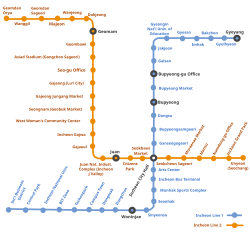Incheon Subway Line 1
This article needs additional citations for verification. (December 2009) |
| Incheon Line 1 | |||
|---|---|---|---|
 | |||
| Overview | |||
| Native name | 인천 1호선(仁川一號線) Incheon Il Hoseon | ||
| Status | Operational | ||
| Termini | |||
| Stations | 29 | ||
| Service | |||
| Type | Rapid transit | ||
| System | Incheon Subway | ||
| Operator(s) | Incheon Transit Corporation | ||
| History | |||
| Opened | October 6, 1999[1] | ||
| Technical | |||
| Line length | 29.4 km (18.3 mi)[2] | ||
| Number of tracks | 2 | ||
| |||
Incheon Subway Line 1 is a 29.4-kilometer (18.3 mi) north-south subway line,[2] part of the Incheon Subway system. The line is also included as a part of the overall Seoul Metropolitan Subway network; Bupyeong Station has a free transfer with Seoul Subway Line 1, Gyeyang Station connects with the AREX Line which leads to Incheon International Airport and Seoul Station, Bupyeong-gu Office Station has a free transfer with Seoul Subway Line 7, and Woninjae Station has a free transfer with the Suin Line.
Background
Incheon's Line 1 makes Incheon the fourth city in Korea with a subway system in South Korea, after Seoul, Busan, and Daegu.
A trip along the line from Gyeyang in the north to Int'l Business District in the south takes approximately 57 minutes. From Bakchon station to International Business District station, the line is underground.
History
- March 1999: Trial runs begin.
- October 6, 1999: The line opens from Bakchon to Dongmak, after six years of construction.
- December 7, 1999: A northern extension from Bakchon to Gyulhyeon opens.
- March 16, 2007: Another northern extension from Gyulhyeon to Gyeyang opens, connecting with the Airport Railroad
- June 1, 2009: A southern extension from Dongmak to International Business District opens.
Future plans
Another southward extension of the line is proposed to provide transportation to Songdo Landmark City. The extension will be 0.84 kilometers (0.52 mi) long and is planned to open in 2018.[3][needs update]
Another northward extension of the line is proposed to provide transportation to the developing Geomdan New City. No opening time has been announced.
Rolling Stock
The line uses 34 8-car trains. The first 25 trains were built between 1998 and 1999 by Daewoo Heavy Industries and Rotem, while the last 9 trains were built between 2007 and 2008 by Hyundai Rotem to provide trains following the extension of the line.
Stations
See also
References
- ^ "History". Incheon Transit Corporation. Retrieved 2014-09-03.
- ^ a b "General information". Incheon Transit Corporation. Retrieved 2015-04-24.
- ^ "사업소개" (in Korean). 도시철도건설본부. Archived from the original on 2013-01-11. Retrieved 2012-06-07.

